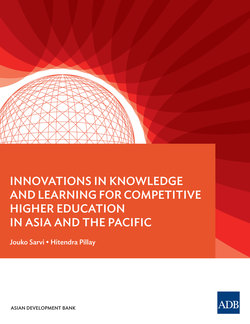Innovations in Knowledge and Learning for Competitive Higher Education in Asia and the Pacific

Реклама. ООО «ЛитРес», ИНН: 7719571260.
Оглавление
Jouko Sarvi. Innovations in Knowledge and Learning for Competitive Higher Education in Asia and the Pacific
INNOVATIONS IN KNOWLEDGE AND LEARNING FOR COMPETITIVE HIGHER EDUCATION IN ASIA AND THE PACIFIC
Contents
Figures. Figures
Abbreviations
Executive Summary
Background and Context
Innovation, Creativity, Inventiveness, and Entrepreneurship
Nature and Types of Knowledge
Applications of Types of Knowledge
Relevance of Knowledge to Current and Future Needs
Innovation in Leveraging the Ubiquity of Knowledge and Learning
ICT-Stimulated Knowledge Innovation Options for Strengthening Capacity and Competitiveness of HEIs
Final Remarks
References
Отрывок из книги
Jouko Sarvi
Hitendra Pillay
.....
Increasingly, recognition of new types of knowledge such as lived experiences, contextual knowledge, and indigenous knowledge has been accompanied by the emergence of constructs such as work-integrated learning, which is permeating all professional disciplines. The separation between formal and informal learning is also becoming blurred due to the ubiquity of knowledge and learning. Increased use of “recognition of prior learning” is being adopted to improve the efficiency of human resource development to provide “job-ready” graduates. The emergence of new disciplines such as creative industries is challenging traditional HEI faculties. The hegemony of global knowledge is also being challenged by nontraditional sources such as developing country, rural, and indigenous knowledge. Inclusive development through increased knowledge sharing between the Anglophone world and others is expanding the scope of knowledge products, services, and applications and changing the expectations of graduates entering the knowledge economy workforce.
Increased access and the ubiquity of knowledge creation and learning confounded by innovations in information and communication technology are disrupting the role of HEIs. The exponential increase in the rate and volume of knowledge products and applications may disrupt traditional structures and timelines of higher education programs if they are to cover the scope and breadth of the knowledge and skills expected of graduates. Flexible modalities, involving external stakeholders and a mix of credit and professional enhancement programs, are gaining recognition as a key part of future higher education service provision. Related to this is the rapid obsolescence of knowledge, which has spawned the growth in continuous professional development (CPD) programs, most of which are modularized and are either delivered online or are site based. To cover the breadth of knowledge types expected by the knowledge workforce, many HEIs provide not-for-credit programs in entrepreneurship and knowledge innovation as value adding and to differentiate themselves from traditional institutions.
.....